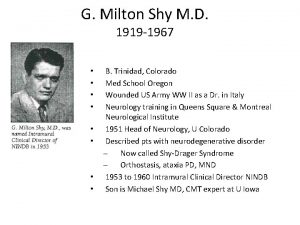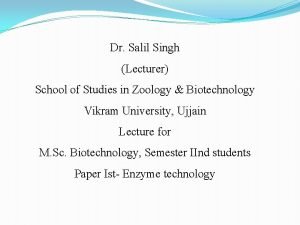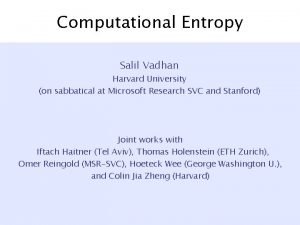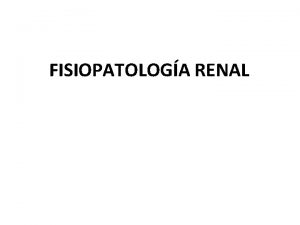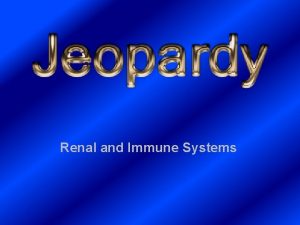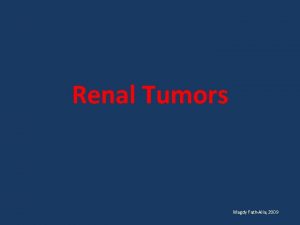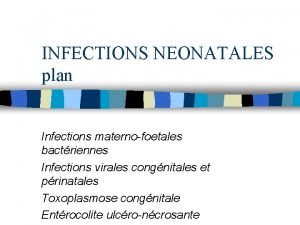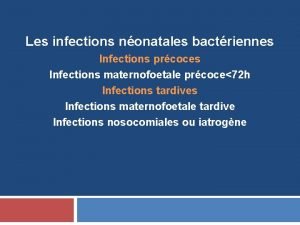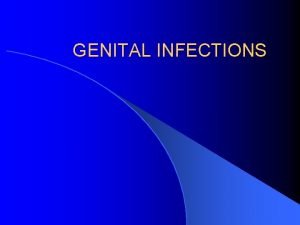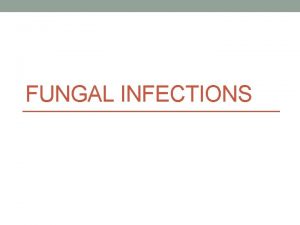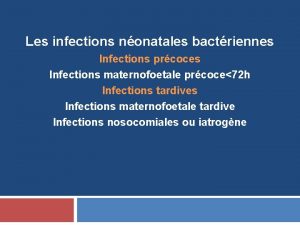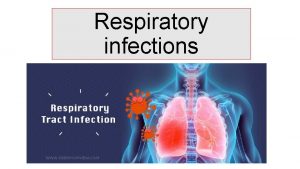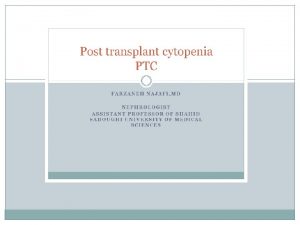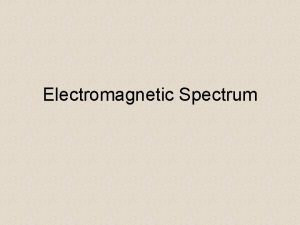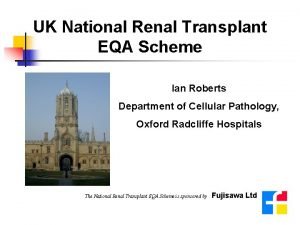Spectrum of Infections in Renal Transplant Dr Salil




















- Slides: 20

Spectrum of Infections in Renal Transplant Dr. Salil Jain Fortis Memorial Research Institute, Gurgaon

INTRODUCTION • CKD- an EPIDEMIC • Prevalence- 1 in 10 • Progressive disease ESRD • 150, 000 - in India on waitlist for renal tx Transplantation Dialysis • Renal tx- 1 out of 30 • 90%- on waiting list die without getting an organ ESRD CKD

COMPLICATIONS OF KIDNEY TRANSPLANT Kidney transplant Rejection Infection Side effects of immunosupressants

Infections ression Immunosupp Rejection

Late presentation Endemic infections eg TB Expensive/non availability of lab tests Lack of awareness in primary care physicians Poor hygiene Infections Socioeconomic status New potent immunosupressives Tropical climate

Post Renal Tx -Infections • Developed vs developing nations- different spectrum of infections • Developing- 25% patients serious infection allograft dysfunction • Infections accounts for 50% deaths in India • Common infections: UTI, TB, Candidiasis, Hepatitis B/C, CMV, Pneumocystis jirovecii

Aim & Objective • To study the incidence of infections in post renal allograft recipient and influence of factors leading to infections • To find out the most common cause of infections in post renal transplant patients • To correlate the incidence of various infections with the literature

Materials and methods • Single Centre observational retrospective hospital based study • Inclusion Criteria: all of the following • All patients who underwent renal transplant from September, 2013 to January, 2017 at FMRI • Patients having regular follow up for at least 3 months post transplant in Outpatient clinic • Exclusion criteria : • Patients lost to follow up after first 3 months • Definition of infection- culture/serology positive with suggestive symptoms

Results Baseline characteristics Variable n No of transplants 150 Males 124 Females 26 Mean age (years) 41. 1 + 14. 66 Dialysis vintage 7. 38 months(15 days to 72 mnths) Primary diagnosis • Hypertension • Diabetes • CGN • Obstructive • PKD • CIN • Unclassified 72 44 14 6 7 5 2

Results Baseline characteristics Variable n(%) Induction IL-2 50 (33. 3%) ATG 91 (60. 7%) No induction 9 (6%)

Patient distribution Infected; 65; 43% No infection; 85; 57%

Spectrum of positive cultures 70. 00% 65. 40% 60. 00% 50. 00% 40. 00% 30. 00% 20. 00% 17. 30% 9. 60% 10. 00% 5. 80% 1. 90% 0. 00% Gram positive Gram negative Fungal Viral TB

Results- type of infection Infections Number of episodes UTI 48 GI infection 27 Pneumonia 11 Soft tissue infection 8 Fungal 3 TB 2 Parvovirus 2 Herpes 2 CMV 2

Spectrum of infection Fungal. TB Soft tissue 3% 2% 8% Pneumonia 11% GI infection 27% UTI 48% UTI GI infection Pneumonia Soft tissue Fungal TB

Spectrum of bacterial infections Bacterial n(%) E. coli 30(34%) Klebsiella 13(14. 7%) Staphylococcus 10(11. 3%) Pseudomonas 7(7. 9%) Enterococcus 7(7. 9%) Acinetobacter 4(4. 5%)

et ob Ac in r as te ac on m do eu Ps us cc s co cc u co ro lo hy En te ap St la el si eb Kl li co E. Bacterial infections-spectrum 35 30 25 20 15 10 5 0

Infection Incidence of infection ATG 46% IL-2 42. 8% Diabetic 43. 2% Nondiabetic 43. 3% P = 0. 69 P= 0. 98

Kumar 2016 R Ram 2005 S Sujit 2016 FMRI No. of patients 45 169 50 150 Mean age (years) 35. 5+10. 4 34. 1+11. 4 - 41. 1 Infection 57 episodes • After 1 year 77. 7% 410 128 105 Induction, ATG vs IL-2 9. 2 vs 6. 8% - NS UTI 33. 3% 23. 6% 72. 7% 46. 6% TB 17. 8% 10. 6% - 1. 9% Fungal 15. 6% 23% 8% 2. 9% CMV 13. 3% 21. 8% 7. 8% 1. 9% HBV 11. 1% 9. 4% 3. 9% 0 HCV 13. 3% 7. 6% Deaths 8. 9% 2. 4% 0 1. 3% 10%

Discussion • Overeall, infection incidence was lower compared to other studies in similar geographical region • Lower rate of CMV due to universal prophylaxis • Lower HBV/HCV due to stringent pretx workup and better medications for their tx. • Fungal/CMV infections have come down considerably in last 10 years due to better prophylaxis and lesser immunosuppression.

Conclusion • Infection still remains one of the most important complication and cause of mortality in transplant patients • UTI continues to be the commonest post transplant infection • We need investigations to monitor immune function to effectively manage immunosuppression • Multicentric prospective studies needed to assess various factors associated with infection • To increase the safety of organ transplantation further, we need improved diagnostic tests to detect infection earlier
 Ira pré renal renal e pós renal
Ira pré renal renal e pós renal Teoria do nefron intacto
Teoria do nefron intacto Cortical and juxtamedullary nephrons difference
Cortical and juxtamedullary nephrons difference Dr salil jain
Dr salil jain Salil vadhan
Salil vadhan Salil manek md
Salil manek md Salil singh
Salil singh Salil vadhan
Salil vadhan Absorption spectrum vs emission spectrum
Absorption spectrum vs emission spectrum Weakness of bohr's atomic model
Weakness of bohr's atomic model Opportunistic infections
Opportunistic infections Innate immunity first line of defense
Innate immunity first line of defense Bone and joint infections
Bone and joint infections Retroviruses and opportunistic infections
Retroviruses and opportunistic infections A bacterial std that usually affects mucous membranes
A bacterial std that usually affects mucous membranes Acute gingival infections
Acute gingival infections Cryptosporidiose
Cryptosporidiose Opportunistic infections
Opportunistic infections Genital infections
Genital infections Storch infections
Storch infections Johnson and johnson botnet infections
Johnson and johnson botnet infections





